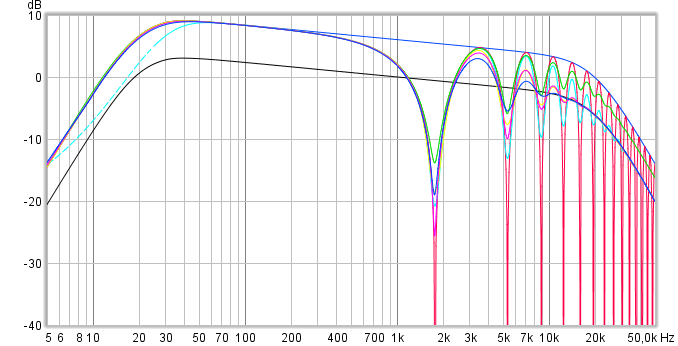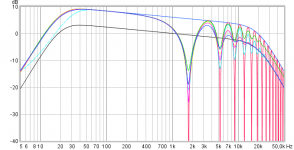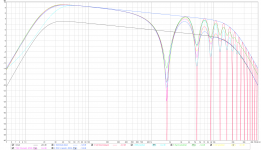I think BYRTT's posting of comb filtering is a red herring, it works for microphones but not ears
Fell free to think whatever about its use or not, maybe a hint to its existence could be move around sit down stand up or turning our head listening to head phones makes no difference to sound.
Last edited:
I don't want a room or speaker set-up that is that sensitive to position so I allow reflections to smooth the response. But my point is that a lot of smoothing is done by the ears and their two receiving positions and the brain filling in the gaps so anything perceived is not going to be anywhere near as dramatic looking as your graph.
For your personal setup if i'm right its OB so agree you have solution with possibility to smooth out a mixed overall response, for point about ears plus brain smooth out stuff is right but problem with shared graph is the error is relative big compared to many comb patterns that is said to be smoothed out by ear and brain, to enlighten error is relative big see below where known smoothing or window has been added and error is still relative big, to decode what filters is used look into legend in second high resolution graph.

Attachments
@scottjoplin Neither do I... I want good sound in the entire listening area. Even way off axis. But that's not the point.
In my humble opinion I think most people that prefer Mono over Stereo might prefer tonal balance over imaging. I know I do value tonal balance more than imaging to listen to. A while ago I got to experience excellent imaging (in a Car of all places) which made me want to have both.
Regular Stereo with highly optimised curves (FIR + PEQ) did not get me there. I was experiencing similar problems as Mark after FIR correcting my speakers. It was a bit of a disappointment. Some songs blew my mind, but I could not enjoy all songs I had liked my whole live.
Over time I started adjusting the tonal balance to cater the phantom centre, where the energy was in most songs. Doing that, the side panned sounds were sounding thin in comparison to the phantom center.
This is the reason I started looking harder at what the underlying problem could be. I tried many things, phase tricks, cross talk cancelation and mid/side EQ. That last one was my ticked to a combination of good or even excellent perceived tonality across the stage while keeping the imaging.
At a later point I added virtual reflections from lateral angles. This provided an even better sense of perceived dynamics and more holographic, 3D like imaging. The mid/side tricks are subtle, nothing like the graph posted by BYRTT, yet it helps my brain to fill in the blanks that much better. It isn't sounding bad off axis, though it did made the sweet spot a lot sweeter. Not a fixed spot, I can move and rotate my head without upsetting the balance.
It was my ticked to get my desired tonal quality while keeping the fun parts of Stereo, and then some.
The reason to write about it (probably more often than I should) is sheer enthusiasm. I'm not forcing anyone to believe me, only bringing it out here as an option to try.
A lot of this has to do with how much reflection is in the room and what balance it has. Many people that have more reflective rooms won't recognise my story telling. Before I started on this quest I just assumed I needed a low level of reflective energy within the first ~20 ms to maximise listening pleasure. Maximise the imaging. I never expected to be worse off in tonal balance. I started with a more reflective room and do remember the good things about that. I also know the differences that made in imaging.
Now I can dial in both to my liking.
Sorry for the long post, ignore me if it isn't interesting. I was reading this thread from the start, as I read a lot of threads without posting, just to hear other peoples opinions and experiences. Always looking to make my puzzle more complete. BYRTT's comb filter graph made me jump in. Not to judge anyone listening in mono, only to provide a possible alternative. It works for me with just about any music I throw at it. Believe me that it was a step up from my first days of using an idealised response for left and right channels, where only a couple of songs sounded excellent. I just could not stop there. The reason for me to build speakers was to be able to enjoy the sound track of my life, not just a couple of audiophile quality recordings.
I'll shut up now .
.
In my humble opinion I think most people that prefer Mono over Stereo might prefer tonal balance over imaging. I know I do value tonal balance more than imaging to listen to. A while ago I got to experience excellent imaging (in a Car of all places) which made me want to have both.
Regular Stereo with highly optimised curves (FIR + PEQ) did not get me there. I was experiencing similar problems as Mark after FIR correcting my speakers. It was a bit of a disappointment. Some songs blew my mind, but I could not enjoy all songs I had liked my whole live.
Over time I started adjusting the tonal balance to cater the phantom centre, where the energy was in most songs. Doing that, the side panned sounds were sounding thin in comparison to the phantom center.
This is the reason I started looking harder at what the underlying problem could be. I tried many things, phase tricks, cross talk cancelation and mid/side EQ. That last one was my ticked to a combination of good or even excellent perceived tonality across the stage while keeping the imaging.
At a later point I added virtual reflections from lateral angles. This provided an even better sense of perceived dynamics and more holographic, 3D like imaging. The mid/side tricks are subtle, nothing like the graph posted by BYRTT, yet it helps my brain to fill in the blanks that much better. It isn't sounding bad off axis, though it did made the sweet spot a lot sweeter. Not a fixed spot, I can move and rotate my head without upsetting the balance.
It was my ticked to get my desired tonal quality while keeping the fun parts of Stereo, and then some.
The reason to write about it (probably more often than I should) is sheer enthusiasm. I'm not forcing anyone to believe me, only bringing it out here as an option to try.
A lot of this has to do with how much reflection is in the room and what balance it has. Many people that have more reflective rooms won't recognise my story telling. Before I started on this quest I just assumed I needed a low level of reflective energy within the first ~20 ms to maximise listening pleasure. Maximise the imaging. I never expected to be worse off in tonal balance. I started with a more reflective room and do remember the good things about that. I also know the differences that made in imaging.
Now I can dial in both to my liking.
Sorry for the long post, ignore me if it isn't interesting. I was reading this thread from the start, as I read a lot of threads without posting, just to hear other peoples opinions and experiences. Always looking to make my puzzle more complete. BYRTT's comb filter graph made me jump in. Not to judge anyone listening in mono, only to provide a possible alternative. It works for me with just about any music I throw at it. Believe me that it was a step up from my first days of using an idealised response for left and right channels, where only a couple of songs sounded excellent. I just could not stop there. The reason for me to build speakers was to be able to enjoy the sound track of my life, not just a couple of audiophile quality recordings.
I'll shut up now
Last edited:
...I'll shut up now.
No problem its very interesting stuff an we can't buy us out of it down the local HiFi shop in getting a new amp or so.
Last edited:
Yes, it is interesting and it's always good to hear your experiments, they are of great value, and your enthusiasm is a breath of fresh air. What you say makes sense to me (mostly). I've thought before about listening in mono, many of the recordings I listen to are mono but through two speakers, I'll have a go listening through one centre speaker to these mono recordings, I'm not denying comb filtering does exist of course just to make that clear 
It is OB, so the first reflections from the side walls are toned down a bit, they are well out into the room and I don't have any additional room treatment other than the usual furnishings. Three of the walls are thick stone. So, I'm guessing the room is probably a little more reflective than average, there is even reasonably acceptable sound behind the speakers, this is for the widebands crossed at 130HzFor your personal setup if i'm right its OB so agree you have solution with possibility to smooth out a mixed overall response,
Yes, it is interesting and it's always good to hear your experiments, they are of great value, and your enthusiasm is a breath of fresh air. What you say makes sense to me (mostly).
ok I will report, maybe you can also give it a try and report back, thank you!
scottjoplin and wesayso could we learn anything if we all three shared a same track recording from middle of the room, i know recording itself sounds nasty disappointing to ones ear compared being there real life but then we have three different setups to compare, one in a treated room with stereo line array verse non treated room with stereo OB and last one is non treated room with mono on wall (FAST).
Last edited:
The most in stereo is mono;-!
Get clean, indifferent speakers - ergo: no multiway - and clean amps - ergo: no multistage-complementary-parts-pp - and sources - ergo: same as amps - and a goo arrangement of speakers and room - ergo: not a high distance of the speakers - and you listen "nearly mono": dynamic, "space", time, homogeneity ... "perfect"-)
Get clean, indifferent speakers - ergo: no multiway - and clean amps - ergo: no multistage-complementary-parts-pp - and sources - ergo: same as amps - and a goo arrangement of speakers and room - ergo: not a high distance of the speakers - and you listen "nearly mono": dynamic, "space", time, homogeneity ... "perfect"-)
Reminds me of what Dick Olsher said about Susumu Sakuma: "When I questioned him specifically about his preference for mono, he responded with a wry smile to the effect that he was too poor to afford a stereo system. The truth is that mono sounds much more realistic than stereo when reproduced in a large hall in front of a large audience."
BYRTT, I'm willing to try but I'm afraid it will be purely subjective, but, that is what we are talking about isn't it? I would be very interested to experiment with the difference between two speaker mono and single centre speaker
@scottjoplin Neither do I... I want good sound in the entire listening area. Even way off axis. But that's not the point.
In my humble opinion I think most people that prefer Mono over Stereo might prefer tonal balance over imaging..................
This sums me up exactly.
........The reason to write about it (probably more often than I should) is sheer enthusiasm. I'm not forcing anyone to believe me, only bringing it out here as an option to try.
This is exactly this sort of original and well considered thought process that keeps me coming back to this site. Your enthusiasm coupled with lack of dogmatism is a joy to read. Thank you for sharing.
I'll shut up now.
I'm a big fan of mono. ... maybe an analogous way to think about it: watching movies in 2D vs 3D. I've seen a couple of good 3D movies but I think I still prefer to watch movies in 2D.
I have been listening to mono for a few months and recently set up a stereo system to test. The stereo mixes; some are better than others but at worst they seem to me contrived, like looking at a lenticular postcard of a "3D" picture. Have you seen those antique stereoscopes that have been around since the late 19th century? You look at two photos at the same time, each shot from a slightly different point to give you an illusion of 3d. Stereoscope - Wikipedia
Its interesting that despite the invention of stereo photography and 3D filmaking, they have not come to dominate visual media, and are still considered somewhat of a gimmick. Making and looking at flat pictures however is something that we have done for thousands of years. For example, the ancient egyptians developed a very eccentric way of showing space on a flat plane. You see the shoulders of a person from the front and the hips and feet from the side. Rembrandt used another set of tricks to make his pictures appear to have 3D space, things in the background of the painting are more blurry and have less contrast. Despite having two eyes, there's is something interesting in the contradictory illusion of looking at a three dimensional space on a 2D surface. You can look at how a filmmaker uses and creates space, even though we are looking at a flat screen. The Moving Image: Space in Touch of Evil
There is also the idea of space as the musicians arrange the notes and various sounds and instruments in space, but another tangent altogether is music's effect on our own sense of space:
"Music and the representation of space
Whereas altered representation of time has been investigated to a greater or lesser extent in empirical studies, there are far fewer investigations on the representation of space while listening to music. By “representation of space” we mean the way people perceive the space around them, such as the distance, size, shape, and movement of objects and other persons. Note that we do not present research on the effect of music on spatial abilities (cf., the Mozart effect) because it is still unclear if this effect really does incorporate a change in the representation of spatial objects (e.g., Husain et al., 2002). There is more anecdotal evidence than assured knowledge of how the representation of space is altered when people are captivated by music."
- Changes in the representation of space and time while listening to music
Maybe there is something that is similar to music as it correlates to pictures, since a lot of musicians and producers in the 50's and 60's thought of the mono mix as their final work and thought that stereo was just a sort of gimmick that would be a passing fad the way the quad format became a passing fad. I assume that most recording engineers now think in terms of stereo, and Ive heard the latest digital dolby surround sound that uses a multitude of speakers in all directions to create an immersive experience. But, I do think there is something special about mono recordings that I enjoy, especially vocals with jazz can sound very spacious, clear and realistic to me in mono. Single full-range driver in mono, I love it!
I have been listening to mono for a few months and recently set up a stereo system to test. The stereo mixes; some are better than others but at worst they seem to me contrived, like looking at a lenticular postcard of a "3D" picture. Have you seen those antique stereoscopes that have been around since the late 19th century? You look at two photos at the same time, each shot from a slightly different point to give you an illusion of 3d. Stereoscope - Wikipedia
Its interesting that despite the invention of stereo photography and 3D filmaking, they have not come to dominate visual media, and are still considered somewhat of a gimmick. Making and looking at flat pictures however is something that we have done for thousands of years. For example, the ancient egyptians developed a very eccentric way of showing space on a flat plane. You see the shoulders of a person from the front and the hips and feet from the side. Rembrandt used another set of tricks to make his pictures appear to have 3D space, things in the background of the painting are more blurry and have less contrast. Despite having two eyes, there's is something interesting in the contradictory illusion of looking at a three dimensional space on a 2D surface. You can look at how a filmmaker uses and creates space, even though we are looking at a flat screen. The Moving Image: Space in Touch of Evil
There is also the idea of space as the musicians arrange the notes and various sounds and instruments in space, but another tangent altogether is music's effect on our own sense of space:
"Music and the representation of space
Whereas altered representation of time has been investigated to a greater or lesser extent in empirical studies, there are far fewer investigations on the representation of space while listening to music. By “representation of space” we mean the way people perceive the space around them, such as the distance, size, shape, and movement of objects and other persons. Note that we do not present research on the effect of music on spatial abilities (cf., the Mozart effect) because it is still unclear if this effect really does incorporate a change in the representation of spatial objects (e.g., Husain et al., 2002). There is more anecdotal evidence than assured knowledge of how the representation of space is altered when people are captivated by music."
- Changes in the representation of space and time while listening to music
Maybe there is something that is similar to music as it correlates to pictures, since a lot of musicians and producers in the 50's and 60's thought of the mono mix as their final work and thought that stereo was just a sort of gimmick that would be a passing fad the way the quad format became a passing fad. I assume that most recording engineers now think in terms of stereo, and Ive heard the latest digital dolby surround sound that uses a multitude of speakers in all directions to create an immersive experience. But, I do think there is something special about mono recordings that I enjoy, especially vocals with jazz can sound very spacious, clear and realistic to me in mono. Single full-range driver in mono, I love it!
Attachments
Last edited:
Single full-range driver in mono, I love it!
There is certainly something to it.
Member
Joined 2009
Paid Member
Well if you have two usable ears since birth then you have been listening to stereo all your life.
Why then would one then have a preference for mono over that of stereo ?
Mono is so dull and boring, with no sense of depth or in the changing location of that sound. Stereo is dimensional and allows for a greater freedom of expression in music. Try listening to the world through one ear all day and ask yourself which is the more enjoyable or seeing through one eye for that matter. Two is what nature intended, one is never better.
C.M
Ah! This is the most important thing to properly understand... When listening to a single speaker, single channel sound, I am not listening with one ear. My ears pick up the sound from the multitude of virtual sound sources, all those boundary reflections etc. Of course, unless you have a medical limitation, you are not listening with only one ear.
The room you are listening in no longer fights, acoustically, with the spatial cues in the source material (whether contrived in mixing or faithful to the recording venue or often somewhere in-between) when you listen through one speaker. You no longer have to listen into the music to find the venue so to speak, your ear-brain has no conflict as it hears the spatial cues of your listening room in a most natural way.
I do also enjoy stereo, but only under a narrow range of controlled circumstances and hence I listen to stereo far less often.
Last edited:
- Status
- This old topic is closed. If you want to reopen this topic, contact a moderator using the "Report Post" button.
- Home
- Loudspeakers
- Multi-Way
- Anybody else tending to MONO ?


